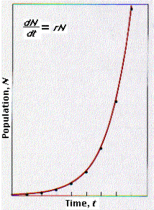Exponential growth
| Topics: |
Contents
Introduction
In population ecology, the population growth rate measures the change in the number of individuals in a population over a specified length of time. Patterns of population growth can be shaped by a variety of factors, and so population biologists have developed different mathematical expressions, or models, to describe population growth rate. One of the most basic expressions of population growth rate is the exponential model. Mathematically, the exponential model is:
In the exponential model, change in population size (dN) over a specified, and usually short, interval of time (dt) is proportional to the product of the per capita growth rate r (where r is the number of individuals added to or subtracted from the population per individual already present in the population per time) and the population size N (where N is the number of individuals present in the population). A population that conforms to this model of population growth will grow exponentially when r > 0, will decline exponentially when r < 0, and will remain constant in size when r = 0, which will occur only when births and deaths are exactly balanced. Exponential growth is best visualized in the graph that plots how the population size changes over time. This graph is often referred to as the "j" curve.
In populations growing exponentially, (1) the number of individuals in a population increases over time, (2) the population growth rate (dN/dt) increases over time (even when the per capita growth rate r remains constant), and (3) the rate at which the population growth rate increases over time, increases over time. Thus, populations growing exponentially will keep growing in size at a faster and faster rate. For example, some bacteria have generations every 20 minutes under optimal conditions. Thus, if we started with a single bacteria, then after only 36 hours the world would be covered by a layer of bacteria one foot thick! Obviously, exponential growth is not a very realistic model of population growth for most species (but see the pattern of human population growth).
Why is the exponential population growth model unrealistic?
In the exponential model, the per capita growth rate is independent of population size (density independent). However, this is unlikely because both per capita birth rate (b) and per capita death rate (d) are expected to change with population size (they are density dependent). For example, competition for resources should be greater as population size increases, leaving fewer resources for each reproducing individual. As a consequence, per capita birth rate should decrease as population size increases (negative density dependent). Similarly, increased competition for resources should result in higher per capita death rates as population size increase because individuals are more likely to die of starvation. In addition, per capita death rates should increase with population size because (1) diseases are transmitted more easily in dense populations and (2) predators may be attracted to regions of high prey density. Thus, per capita death rates should be positively density dependent. Thus, as populations increase in size, per capita birth rates are expected to decline and per capita death rates are expected to increase.
Because per capita growth rate is a function of the per capita birth and death rates (r = b - d), exponential growth is not a realistic model for populations in which birth and death rates vary as a function of population size, as will generally be the case when resources are not unlimited. Most populations seem to exhibit density-dependent birth and death rates, and thus the exponential model of population growth is not broadly useful in describing population growth. However, the exponential model is useful in certain cases, for example in describing and predicting population growth when a species is introduced to a new environment with abundant resources without competitors or predators. The exponential model of population growth also serves as foundation for other, more realistic models such as the logistic growth model.
Further Reading
- Campbell, N.A., J.B. Reece, and L.G. Mitchhell. 2006. Biology. Addison Wesley Longman, Inc. Menlo Park, CA. ISBN: 080537146X
- Gotelli, N. J. 2001. A primer of ecology. Sinauer Associates, Inc. Sunderland, MA. ISBN: 0878932704
- Raven, P.H., G.B. Johnson, J.B. Losos, K.A. Mason, and S.R. Singer. 2008. Biology, 8th edition. McGraw Hill, New York, NY. ISBN: 0073227390
